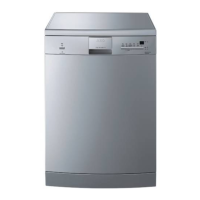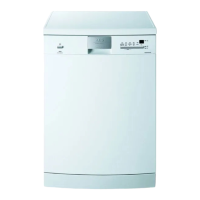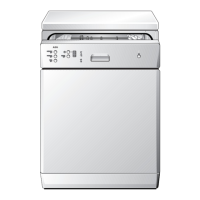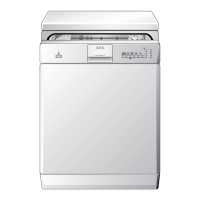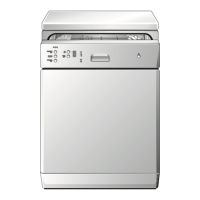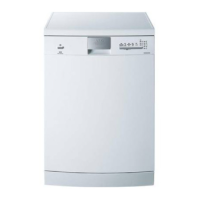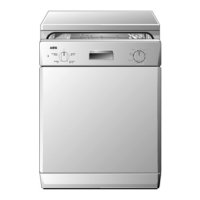Do you have a question about the AEG FAVORIT 40740 and is the answer not in the manual?
Instructions for transporting, connecting, and initially operating the dishwasher.
Precautions and warnings regarding children's interaction with the appliance.
Guidelines for repairs and general safety precautions for appliance use.
Guidelines for proper operation, including detergent use, solvent prohibition, and anti-flood system.
Guidelines for disposing of packaging materials and old dishwashers safely.
Tips for efficient and eco-friendly operation, including water softener, load sensor, and detergent use.
Visual identification of key components like spray nozzles, salt container, and rinse aid dispenser.
Labels for the water hardness switch, salt container, detergent container, and rinse aid container.
Identification of buttons like water softener, function, and start delay, and displays.
Explanation of the 3 lights on the multidisplay indicating wash stage or faults.
Meaning of control indicators for refilling salt and rinse aid.
Steps to prepare the dishwasher for first use, including water softener and salt/rinse aid.
Explanation of the water softener's role in preventing scale deposits and its settings.
Table detailing water hardness levels and corresponding manual/electronic settings.
Step-by-step guide to manually adjust the water softener using the hardness range switch.
Detailed procedure for electronically setting the water softener via control buttons.
Conditions under which special salt is necessary or not needed.
How to set the water softener manually and electronically based on salt usage.
How to adjust the salt inflow, especially concerning 3-in-1 tablets.
Step-by-step instructions for filling the salt container with special salt.
Information on salt dissolution, water expulsion, and the salt indicator light.
Explanation of rinse aid's role in rinsing and drying, and how to add it.
Procedure to enable or disable the rinse aid dispensing function.
How the display indicates whether rinse aid is dispensed or not.
Procedure for saving the selected rinse aid dispensing function setting.
Step-by-step instructions for filling the rinse aid compartment.
Explanation of rinse aid release and adjustment from 1 to 6 for optimal drying.
Step-by-step guide to adjust the rinse aid dose level.
Steps for daily use: check levels, load, fill detergent, select programme, start.
Guidelines on what not to wash and how to load dishes for optimal cleaning.
Advice on loading dishes to avoid spray arm obstruction and ensure proper water access.
Safety warnings about sharp cutlery and proper placement in the basket.
Instructions for arranging cutlery in the basket for effective washing.
Steps for opening and handling the two-part cutlery basket if present.
Guidance on loading large and heavily soiled dishes in the lower basket.
How to fold down plate inserts in the lower basket for larger items.
How to fold down rear plate inserts in the lower basket for larger items.
Instructions for loading small, delicate items and long cutlery in the upper basket.
Tips for arranging cups, glasses, and coffee services for optimal washing.
Table showing maximum dish heights with the upper basket raised or lowered.
Step-by-step instructions for lowering the upper basket to accommodate taller items.
Step-by-step instructions for raising the upper basket to optimize space.
Guidance on using only dishwasher detergent and observing manufacturer recommendations.
Identification of the detergent compartment on the inside of the dishwasher door.
Instructions on how to open the dispenser and fill it with the correct amount of detergent.
Advice on checking water hardness compatibility and correct placement of 3-in-1 tablets.
Recommendations for switching back to standard detergent systems, including refilling compartments.
Classification of detergents based on chemical composition and enzymes.
Benefits of using 50°C programmes with concentrated detergents for efficiency and dish care.
Explanation of why some tablets may not perform well on short programmes.
Recommendation to use programmes with a pre-wash cycle when using detergent tablets.
Table to help choose the most suitable wash programme based on dish type and soiling.
Information on programme sequence, consumption figures, and duration for key programmes.
Steps before starting, including checking dish loading and turning on the water tap.
How to select a programme and start the dishwasher.
Warning about potential water collection in the base when interrupting and restarting.
Procedure to change a selected wash programme after it has started.
How to interrupt the programme by opening the door and continuing it.
Steps to completely cancel a running wash programme using function buttons.
How to set a delayed start for the wash programme (3, 6, or 9 hours).
Methods to modify or cancel a previously set start delay.
How to change the programme before the delayed start begins.
Explanation of how the load sensor adjusts water and duration for fewer dishes.
Instructions on how to switch off the dishwasher after the programme is complete.
Advice on allowing dishes to cool and unloading order for best results.
Warnings against using harsh cleaners and advice on cleaning controls and seals.
Step-by-step guide to cleaning the dishwasher's filter components.
Critical warning that the dishwasher must not be operated without filters.
Troubleshooting table for error messages related to water supply and filter blockages.
Instructions on contacting Service Force for unlisted error codes.
Solutions for common problems like the door not closing or delayed start selection.
Explanations and solutions for rust spots and whistling noises during operation.
Causes and solutions for dishes not being cleaned properly, including programme and loading errors.
Troubleshooting scale deposits and poor wash results due to salt or detergent issues.
Reasons for wet or dull dishes, like insufficient rinse aid or empty rinse aid container.
How to address dried water drops, possibly related to rinse aid or detergent.
Key technical details like capacity, water pressure, dimensions, and weight.
Information regarding compliance with relevant EU Directives.
Information relevant to test institutes regarding EN 60704 and EN 50242 standards.
Diagrams illustrating recommended loading patterns for upper and lower baskets during testing.
Instructions for stable and level installation, adjusting feet, and routing hoses.
Note referring to separate installation instructions for built-under models.
Guidelines for setting up the dishwasher as a free-standing unit, including heat insulation.
Requirement to re-mount the original work surface if used as a free-standing appliance.
Details on connecting to a cold water supply and restrictions on hot water connections.
Information on minimum and maximum water pressure limits for the appliance.
Instructions for connecting the water inlet hose to the tap, including tightening methods.
Explanation of how the safety valve cuts off water in case of leaks.
Precautions for installing the water inlet hose, including distance and damage checks.
Guidelines for connecting the drain hose, including height restrictions and extension hoses.
How to connect the drain hose to a sink outlet, including hose clamp usage.
Instructions for proper drainage when using a standpipe.
Description of the leak prevention system and its operation during faults.
How the leak prevention system functions even when the appliance is powered off.
Warning that electrical work should only be performed by qualified personnel.
Importance of earthing the appliance and matching supply voltage to the rating plate.
Instructions for replacing the fuse in the appliance's plug.
Example of how water inlet, drain hoses, and mains cable are connected.
Conditions for the standard 12-month guarantee, including proper installation and use.
List of conditions and parts not covered by the guarantee.
Information on how the guarantee moves with the user to another European country.
Telephone number and website for contacting Service Force for repairs and spare parts.
Details needed when contacting Service Force, including fault description and appliance model.
Contact information for general inquiries, product information, and customer care.
Instructions for transporting, connecting, and initially operating the dishwasher.
Precautions and warnings regarding children's interaction with the appliance.
Guidelines for repairs and general safety precautions for appliance use.
Guidelines for proper operation, including detergent use, solvent prohibition, and anti-flood system.
Guidelines for disposing of packaging materials and old dishwashers safely.
Tips for efficient and eco-friendly operation, including water softener, load sensor, and detergent use.
Visual identification of key components like spray nozzles, salt container, and rinse aid dispenser.
Labels for the water hardness switch, salt container, detergent container, and rinse aid container.
Identification of buttons like water softener, function, and start delay, and displays.
Explanation of the 3 lights on the multidisplay indicating wash stage or faults.
Meaning of control indicators for refilling salt and rinse aid.
Steps to prepare the dishwasher for first use, including water softener and salt/rinse aid.
Explanation of the water softener's role in preventing scale deposits and its settings.
Table detailing water hardness levels and corresponding manual/electronic settings.
Step-by-step guide to manually adjust the water softener using the hardness range switch.
Detailed procedure for electronically setting the water softener via control buttons.
Conditions under which special salt is necessary or not needed.
How to set the water softener manually and electronically based on salt usage.
How to adjust the salt inflow, especially concerning 3-in-1 tablets.
Step-by-step instructions for filling the salt container with special salt.
Information on salt dissolution, water expulsion, and the salt indicator light.
Explanation of rinse aid's role in rinsing and drying, and how to add it.
Procedure to enable or disable the rinse aid dispensing function.
How the display indicates whether rinse aid is dispensed or not.
Procedure for saving the selected rinse aid dispensing function setting.
Step-by-step instructions for filling the rinse aid compartment.
Explanation of rinse aid release and adjustment from 1 to 6 for optimal drying.
Step-by-step guide to adjust the rinse aid dose level.
Steps for daily use: check levels, load, fill detergent, select programme, start.
Guidelines on what not to wash and how to load dishes for optimal cleaning.
Advice on loading dishes to avoid spray arm obstruction and ensure proper water access.
Safety warnings about sharp cutlery and proper placement in the basket.
Instructions for arranging cutlery in the basket for effective washing.
Steps for opening and handling the two-part cutlery basket if present.
Guidance on loading large and heavily soiled dishes in the lower basket.
How to fold down plate inserts in the lower basket for larger items.
How to fold down rear plate inserts in the lower basket for larger items.
Instructions for loading small, delicate items and long cutlery in the upper basket.
Tips for arranging cups, glasses, and coffee services for optimal washing.
Table showing maximum dish heights with the upper basket raised or lowered.
Step-by-step instructions for lowering the upper basket to accommodate taller items.
Step-by-step instructions for raising the upper basket to optimize space.
Guidance on using only dishwasher detergent and observing manufacturer recommendations.
Identification of the detergent compartment on the inside of the dishwasher door.
Instructions on how to open the dispenser and fill it with the correct amount of detergent.
Advice on checking water hardness compatibility and correct placement of 3-in-1 tablets.
Recommendations for switching back to standard detergent systems, including refilling compartments.
Classification of detergents based on chemical composition and enzymes.
Benefits of using 50°C programmes with concentrated detergents for efficiency and dish care.
Explanation of why some tablets may not perform well on short programmes.
Recommendation to use programmes with a pre-wash cycle when using detergent tablets.
Table to help choose the most suitable wash programme based on dish type and soiling.
Information on programme sequence, consumption figures, and duration for key programmes.
Steps before starting, including checking dish loading and turning on the water tap.
How to select a programme and start the dishwasher.
Warning about potential water collection in the base when interrupting and restarting.
Procedure to change a selected wash programme after it has started.
How to interrupt the programme by opening the door and continuing it.
Steps to completely cancel a running wash programme using function buttons.
How to set a delayed start for the wash programme (3, 6, or 9 hours).
Methods to modify or cancel a previously set start delay.
How to change the programme before the delayed start begins.
Explanation of how the load sensor adjusts water and duration for fewer dishes.
Instructions on how to switch off the dishwasher after the programme is complete.
Advice on allowing dishes to cool and unloading order for best results.
Warnings against using harsh cleaners and advice on cleaning controls and seals.
Step-by-step guide to cleaning the dishwasher's filter components.
Critical warning that the dishwasher must not be operated without filters.
Troubleshooting table for error messages related to water supply and filter blockages.
Instructions on contacting Service Force for unlisted error codes.
Solutions for common problems like the door not closing or delayed start selection.
Explanations and solutions for rust spots and whistling noises during operation.
Causes and solutions for dishes not being cleaned properly, including programme and loading errors.
Troubleshooting scale deposits and poor wash results due to salt or detergent issues.
Reasons for wet or dull dishes, like insufficient rinse aid or empty rinse aid container.
How to address dried water drops, possibly related to rinse aid or detergent.
Key technical details like capacity, water pressure, dimensions, and weight.
Information regarding compliance with relevant EU Directives.
Information relevant to test institutes regarding EN 60704 and EN 50242 standards.
Diagrams illustrating recommended loading patterns for upper and lower baskets during testing.
Instructions for stable and level installation, adjusting feet, and routing hoses.
Note referring to separate installation instructions for built-under models.
Guidelines for setting up the dishwasher as a free-standing unit, including heat insulation.
Requirement to re-mount the original work surface if used as a free-standing appliance.
Details on connecting to a cold water supply and restrictions on hot water connections.
Information on minimum and maximum water pressure limits for the appliance.
Instructions for connecting the water inlet hose to the tap, including tightening methods.
Explanation of how the safety valve cuts off water in case of leaks.
Precautions for installing the water inlet hose, including distance and damage checks.
Guidelines for connecting the drain hose, including height restrictions and extension hoses.
How to connect the drain hose to a sink outlet, including hose clamp usage.
Instructions for proper drainage when using a standpipe.
Description of the leak prevention system and its operation during faults.
How the leak prevention system functions even when the appliance is powered off.
Warning that electrical work should only be performed by qualified personnel.
Importance of earthing the appliance and matching supply voltage to the rating plate.
Instructions for replacing the fuse in the appliance's plug.
Example of how water inlet, drain hoses, and mains cable are connected.
Conditions for the standard 12-month guarantee, including proper installation and use.
List of conditions and parts not covered by the guarantee.
Information on how the guarantee moves with the user to another European country.
Telephone number and website for contacting Service Force for repairs and spare parts.
Details needed when contacting Service Force, including fault description and appliance model.
Contact information for general inquiries, product information, and customer care.
| Type | Freestanding |
|---|---|
| Delay Start | Yes |
| Half Load Option | Yes |
| Washing programs | Eco, Intensive, Quick |
| Programs | Eco, Intensive, Quick |
| Dimensions (H x W x D) | 850 x 600 x 600 mm |


